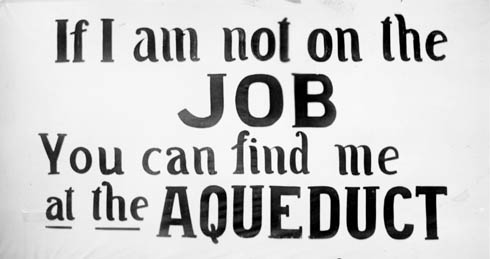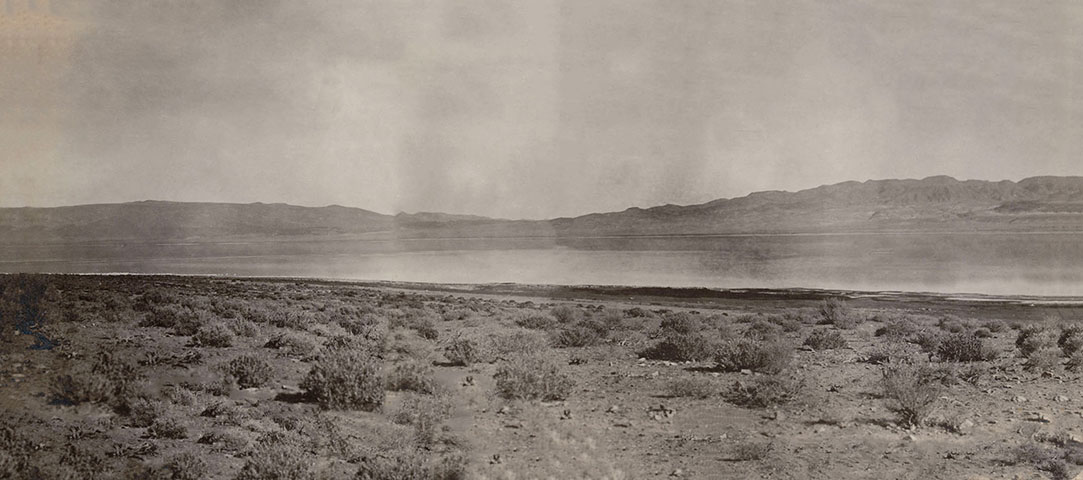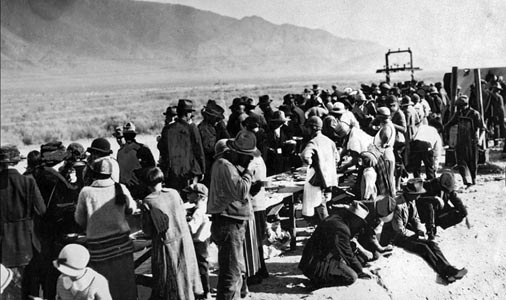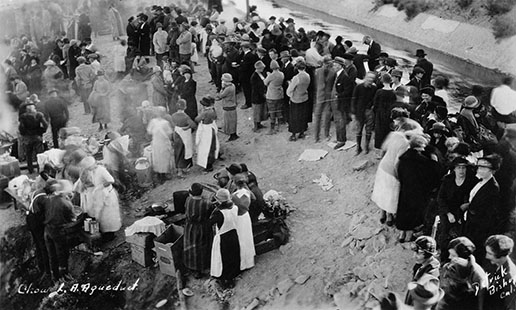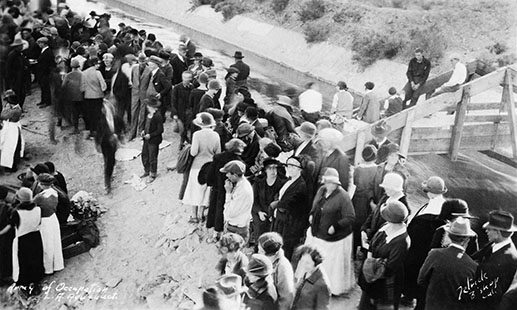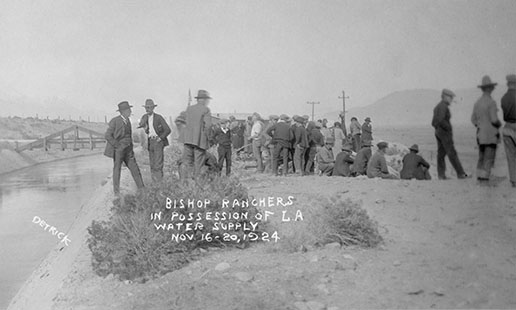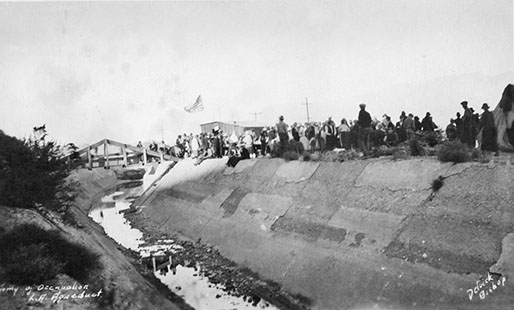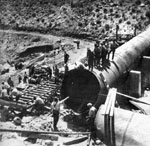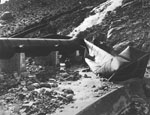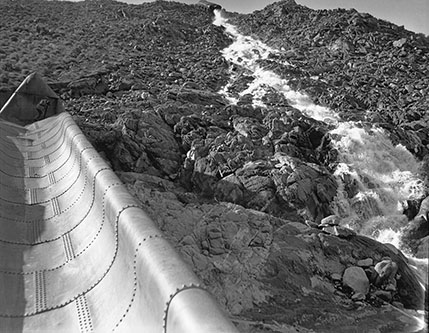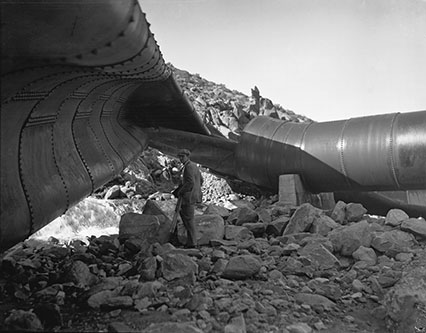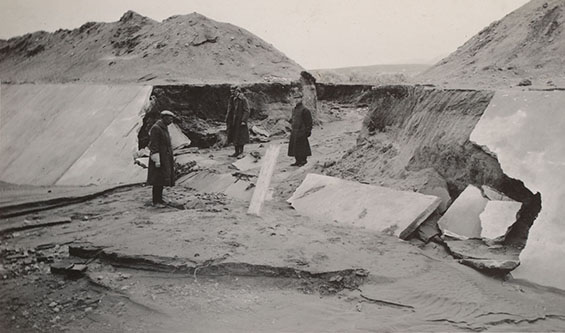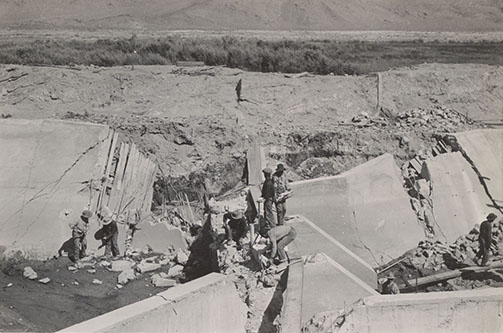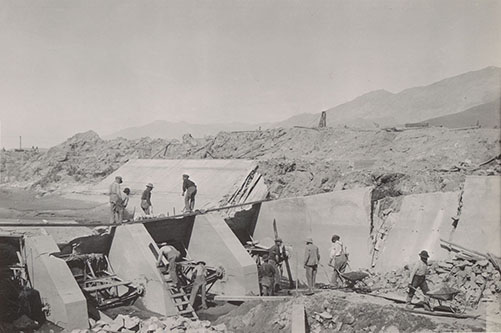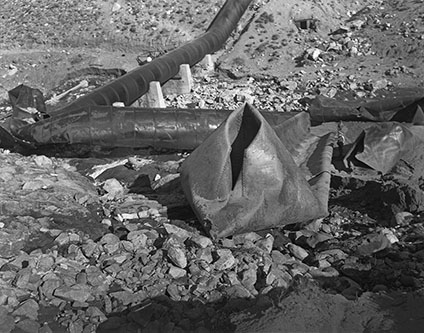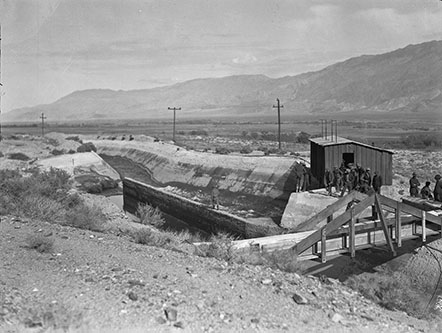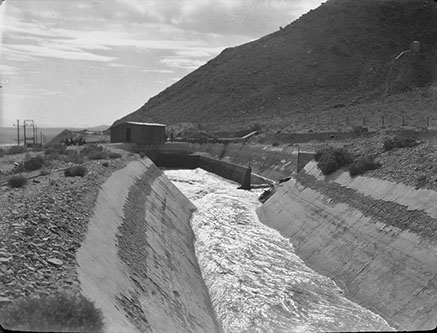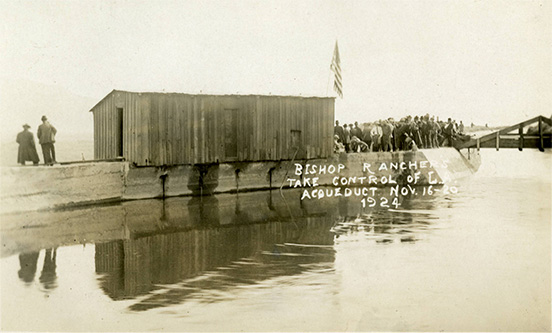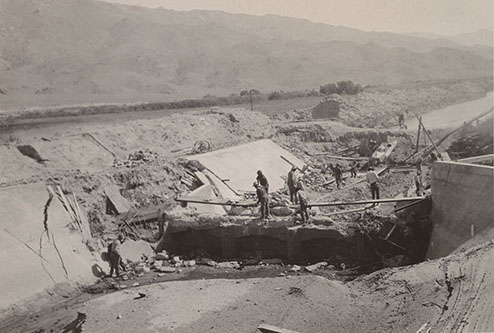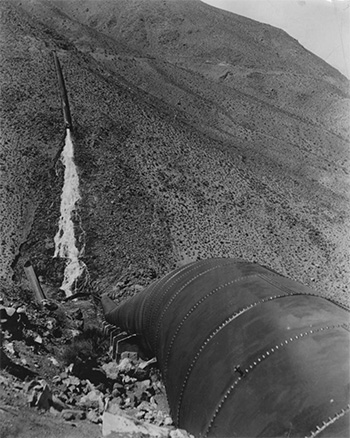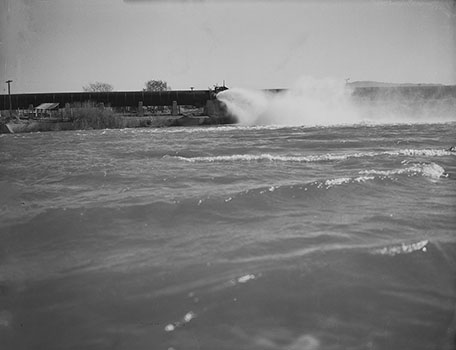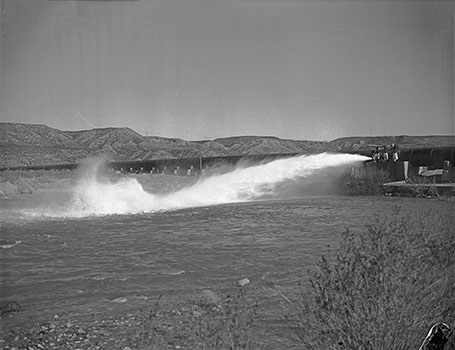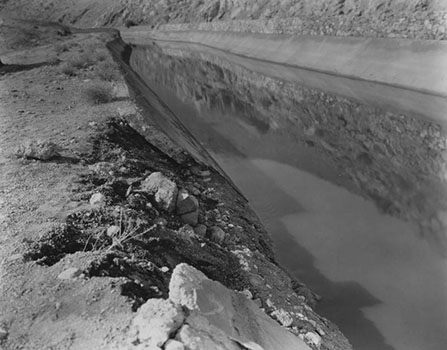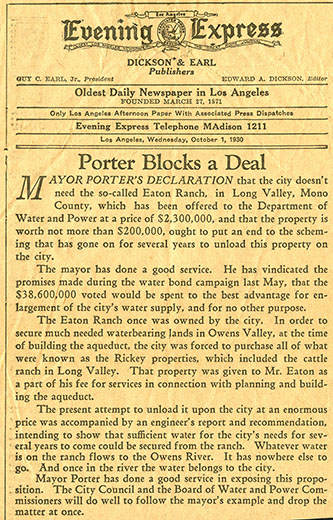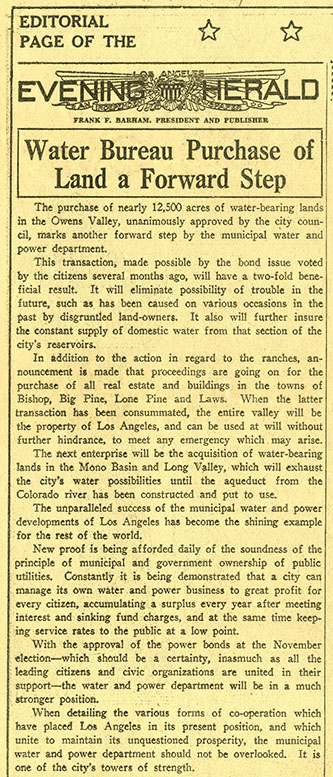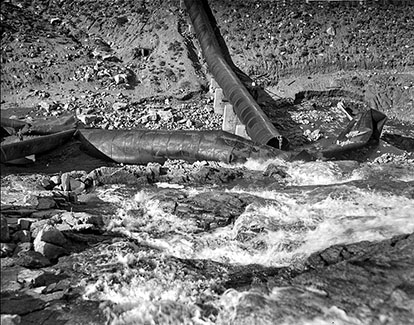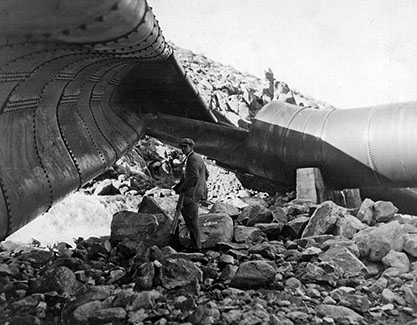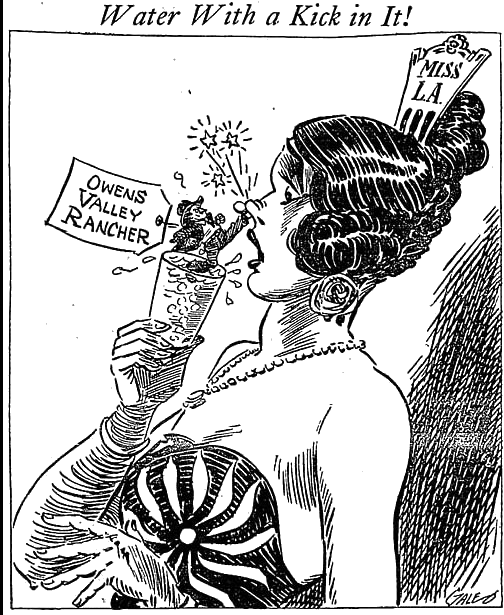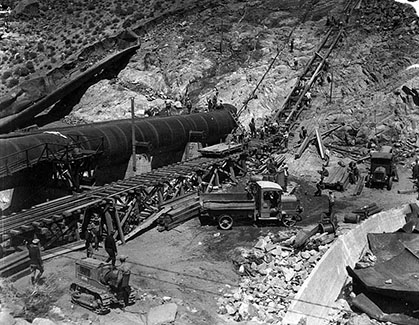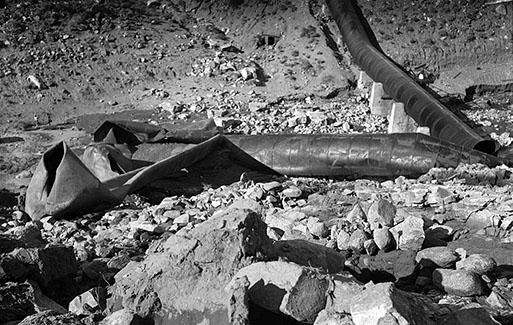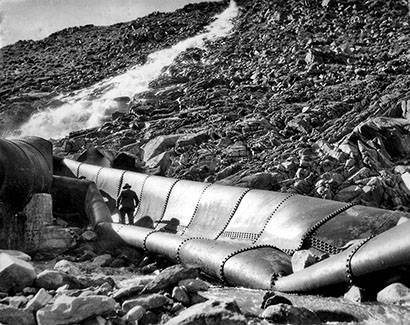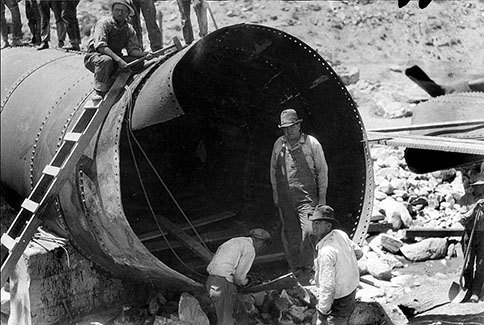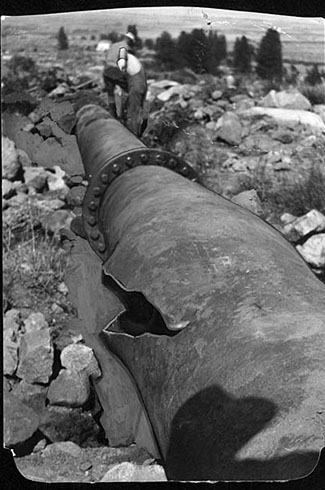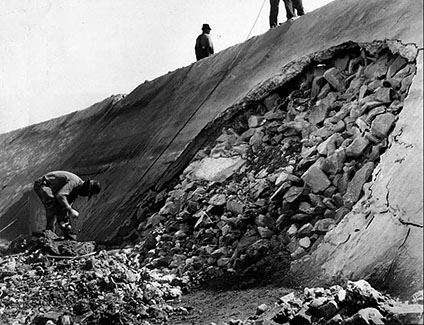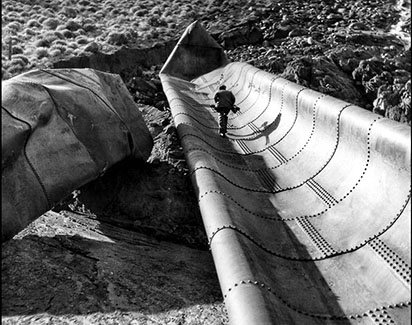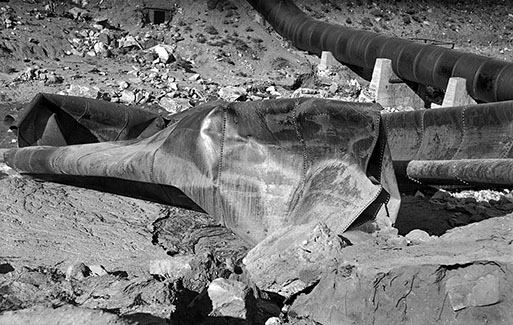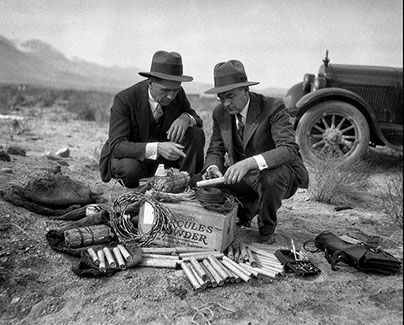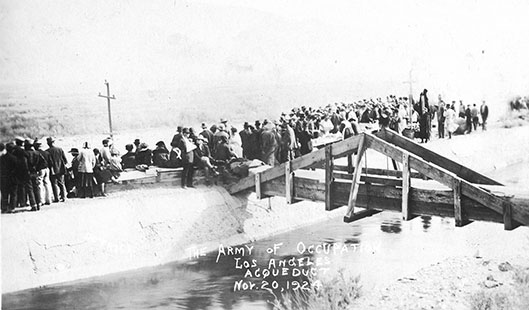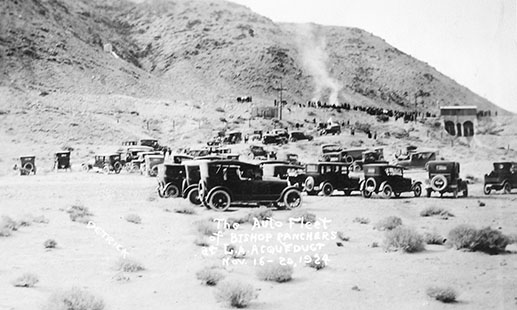Owens Valley's
- Los Angeles Aqueduct
![]()

If I am not on the JOB, You can find me at the AQUEDUCT was the rallying cry for the people of Bishop, California, during their occupation of the Alabama Gates of the Los Angeles Aqueduct. The slogan was posted in Bishop to inform persons where the townspeople had gone--to the Aqueduct. |
|
See USE NOTICE on Home Page. |
 The Los Angeles Times |
|
1924 November |
Peace Moves are Started in War Over Aqueduct |
1925 January |
Legislature Takes Hand in Owens Valley Row - [Fellony to Damage the Aqueduct] |
1927 May |
Police Ready to Rush North |
Historical Background |
| To meet the need for water of its growing population, the City of Los Angeles began buying land and corresponding water rights in the Owens Valley in 1905. In 1913, the great Los Angeles Aqueduct was completed to bring Owens Valley water to the city. In 1923, the City of Los Angeles began acquiring more land in the Owens Valley to gain further sources of water. To protest the failure of Los Angeles to address their grievances, Owens Valley farmers and ranchers, under the leadership of Bishop, California banker Mark Watterson, seized the Alabama Gates, on 16 November 1924. The Gates divert water to a spillway allowing water to flow to the lower Owens River, which leads to the now dry Owens Lake. During the occupation water was let from the aqueduct into the Owens River bed, at that time dry (it has now been partially restored). After townspeople from Bishop joined the occupation, the number of occupiers reached seven hundred. It lasted until 20 November, and brought both national and international press coverage to the plight of the Owens Valley residents. The occupation and resulting favorable publicity did nothing to halt the City of Los Angeles' continued acquisition and subsequent control of land in the valley. The famous Alabama Hills, the site of many a western movie, are in the background. |
 Aqueduct Blast Suspect to Get Hearing Today The Los Angeles Times - July 26, 1927 |
MARTINEZ (Cal.) - July 26. (AP) - C. P. Watson, former United States Army officer, is to be arraigned hee tomorrow on the three grand-jury charges linking him with the purchase of 700 pounds of explosives in Contra Costa county. The charges intimated that Watson was suspected of having had a hand in at least one of the recent blastings of the Los Angeles Aqueduct in Owens Valley, Southern California. Watson's attorneys returned here today from an investigation of conditions in Owens Valley, where they defendant owns a ranch. They declared that Watson would plead not guilty to the charges agains him. After his first appearance in the courts here Watson declared that before his trial was finished "the reputation of someone in Los Angeles would be blasted." |
 |
Arbitration and Dynamite Los Angeles Times - 07-19-1927 |
| By a pecullar coincidence the ninth and tenth attempts on the part of Owens Valley outlaws to destroy the Los Angeles Aqueduct by dynamite occurred at almost the exact hour at which was released for publication the letter to Governor Young of the various reparations associations and property-owners' protective associations of the Owens Valley in which they rejected the Governor's proposal that the differences between them and the city of Los Angeles should be submitted to the arbitration o! the courts. The roar of the newspaper presses which carried to the world the refusal of these dissatisfied property owners to ablde by the decision of the State's chief executive, to whom they had themselves appealed, mingled with the roar of splintering bombs almost as much as to proclaim the preference of certain malcontents, at least, to settle their scores with the tools of anarchy rather than with those of law and order. The reasons assigned for the rejection of judicial arbitration lack adequacy. "Courts are guided by precedent," says the communication to the Governor, "and there is no precedent for the consequential damage we are asking." It may be inferred from the statement that its authors do recognize precedents for the dynamite outrages, referred to In the letter and not disclalmad. The history of anarchy is replete with bombing precedents. Enemies of order everywhere have had recourse to the bomb and the torch, but, though they have wrought disaster and death, their own cause has invariably gone down in the wreckage. The letter refers to the ten successive dynamitings of the Aqueduct casually and defensively, mitigating and minimizing the damage and without a word of disavowal or disapproval. If the dynamiters do not enjoy the open sympathy and support of the authors of the statement, at least they do not suffer censure from that source. But, not without unconscious humor, the letter protests vigorously that "in defiance of the law, armed guards of the city are patrolling the roads and highways of our valley." Of what would happen to the Aqueduct if these guards were withdrawn the communication does not hint. In view of the fact that the dynamitings continue despite the discouraging presence of the guards, such an intimation was perhaps unnecessary. The contention that precedent is lacking to guide a court in adjudicating the rights of this case ls a weak and preposterous excuse for the outlawry which the valley allows to continue without a single effective move on the part of its so-called law-enforcement officers. Even if there were not a wealth of law and precedent touching the subject, courts are amply able to and habitualy do create their own precedents when justice requires. The second reason given for refusing the offices of the courts in the Owens Valley cases Is hardly less puerile. "Any court action . . . would doubtless be frustrated by innumerable delays and technicalities Iinjected by the Water and Power Board," the letter says. Comment ls scarcely necessary, but it may be pointed out in passing that if the city officials were disposed to adopt such tactics they could employ them much more effectively by bringing court action against any awards made by an unofficial board of arbitration such as the statement's authors declare they want. In connection with this demand for an "impartial board of arbitration" it should not be forgttten that the city has so far paid for Owens Valley water lands on the basis of awards made by a board composed entirely of residents of the valley, all of them experts in land values, and that such payments have averaged two and a half times the market price. A board which would give more favorable terms - from the valley standpoint - could hardly be hoped for. It is conceded by all who have examined the situation that the city's purchases of valley lands have wrought a grave financial hardship on business man and property owners in the valley towns. These people have seen their businesses and their realty values shrink grievously and have not. been compensated for their losses. That they have a just claim no one disputes. The city is able to pay and willing to pay - it merely remains for competent authority to fix the amount of the damage. Universally, the courts have been the accepted media for fixing such damages in other and similar cases. But the valley, or such part of it as may be represented by these associations, refuses to permit the courts to exercise their custorµary functions in the matter. The dispute is, therefore, back where It started - with dynamite on one hand and guards on the other, with the Aqueduct blown up in a new place every few nights and with Owens ValJey, her great summer tourist and camping business ruined, fast approaching the grim record of Bloody Williamson county as a seat of lawlessness. The Aqueduct must be protected and will be protected if it takes the whole might of the State to do it. No sane person wishes to withhold from Owens Valley a dime in damages that is rightfully hers, but every new outrage that the valley permits will set public opinion more strongly against her and make justice more difficult to do. |
Camp at Aqueduct Gate is Center of Family Life
by Otis M. Wiles
City Fixes Towns' Price
by Chester G. Hanson
Owens Valley "Facts" Printed
by Los Angeles Times - January 9, 1925

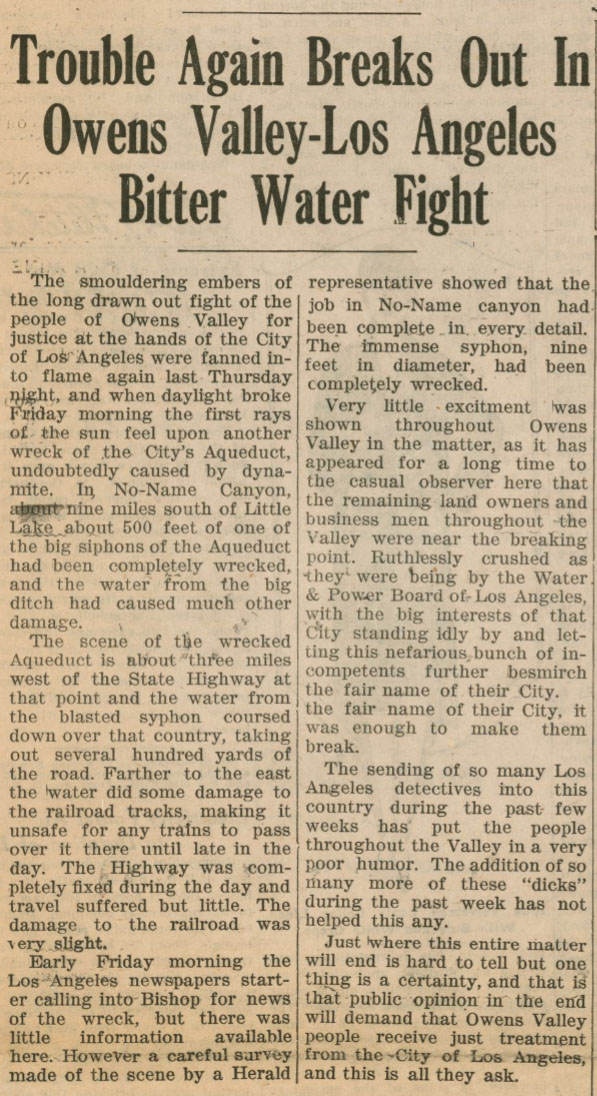
Ranch Men in Favor of City Offer Definite Action on Owens Land Purchase Awaiting Specific Price List by A. P. Night Wire |
| BISHOP, Jan. 29. - Land and water owners of Owens Valley today began an unofficial consideration of the offer last night of the Los Angeles Board of Public Service Commissioners to open negotiations for the purchase of all remaining privately owned land, and water rights in the Owens Valley Irrigatioin District - the principal source of the city's water supply - and thus endeavor to bring to a close a controversy of more than twenty years standing. The attitude with which the city's proposal was met, was favorable, according to those close to the situation in this sectioin, but it was the general expression that that part of the offer stating that negotiations will be opened at a price based upon past land purchases, will have to be made more specific before definite action can be taken. The sentiment in favor of opering negotiations, it was made clear, was base upon the assumption that the price to be paid will be fair and that the purchases will be made collectively and not in the heretofore piece-meal manner, which the valley interests contend has turned large sections of the district into desert, and thus has been the underlyi ng cause of their troubles. The refusal of the city to consider reparations for alleged damage done to the valley towns through the piece-meal purchases, caused considerable adverse comment, but it was indicated that if the farmers get a favorable price, the other will not be insisted upon. |
 WATCHING OWENS VALLEY Santa Ana Register - 1924 |
All Southern California is Watching with keen interest the drama that is being enacted in the Owens valley with ranchers on one side and the great city of Los Angeles on the Other. It is a drama that has been enacted on a smaller scale many times in California, with water as the cause of contest. Litigation over water rights has often been hastened or hindered when one of the disagreeing parties has taken the law in its own hands. The ranchers of the Owens valley have taken the law into their own hands deliberately. They want to bring to a head the controversy that has long existed. Desiring water to meet the needs of a growing city, recognizing the fact that any city's growth is limited by its water supply, Los Angeles went into the Owens valley and by purchase took a large share of the water. Resentment against the big city has been expressed innuberable times in varioius ways. With water, the Owens river country can expect no further development. The interior valley's future has been sacrificed to the future of Los Angeles. Because Los Angeles has been for itself alone in going out after a water supply, and because thee is an established principle of law known as that of eminent domain, the greatest good to the greatest number being its foundation stone, all Soiuthern California has been wondering for some years as to what their fate might be should the time come, as it plainly might, when Los Angeles would need all the water in Southern California in order to meet its municipal needs. In recent months this nervousness concerning the future has been somewhat relieved through the announcement of a project for bringing water from the Colorado River to meet the needs for domestic water in the cities of Los Angeles, Orange, Riverside and San Bernardino counties. When we look ahead thirty, forty or fifty years, and when we contemplate the probabilities of the growth of Los Angeles, as well as the growth of other cities of Southern California, we can conjecture that the Colorado River will be the agent that will preserve our agriculture and our horticulture. In order to secure ample water supplies, the cities must either take water away from farms and orchards or go to the Colorado. The fight that the Owens valley is making today - and it looks like a hopeless fight - is a fight that may be made some day in Orange county. Who knows? Our insurance against any such a situation lies in joining with Los Angeles in bringing water from the Colorado river, and by so doing water now in use for irrigation of farming and orchard lands can be preserved indefinitely for that use. Otherwise this water may be sacrificed some day, if not in this generation then in the next, to the needs of the people in the cities. |
INYO COUNTRY FACES SUIT FOR DAMAGE Public Service Counsel Seeks Authority to File Action in Water Row Los Angeles Daily Times - 1924 |
| W. B. Mathews, chief counsel for the Board of Public Service Commissioners said yesterday that he expected to find authority for a damage suit by the city of Los Angeles against Inyo county under the California code. Under the California code, Section 4452, it would appear that legal redress for damages done or caused by either a mob or by riots, damage being either real or personal, would be granted Los Angeles, Mr. Mathews said. Admission by the Sheriff of Inyo county that he is unable to protect the Aueduct constitutes sufficient grounds for a damage suit, Mr. Mathews said. Civil suits against individuals concerned in the present water fight have already been filed. During the railroad riots in Allegheny county, Pennsylvania, in 1873, suits against the count for damages done by strikers amounted to several millions of dollars. The count was found liable and forced to float a bond issue of $10,000,000 to pay outstanding claims. Mr. Mathews said last night that if he finds a proper authority he will institute suit against the county of Inyo, in which even those innocent of any wrong doing in the present water battle would be forced to share an additional tax burden with members of the present rancers' mob that has defied court orders and is continuing to wast water valued at $15,000 daily by the city of Los Angeles. |
Photo courtesy of the water Resources Center Archives, Orbach Science Library, University of California, Riverside, CA, |
|
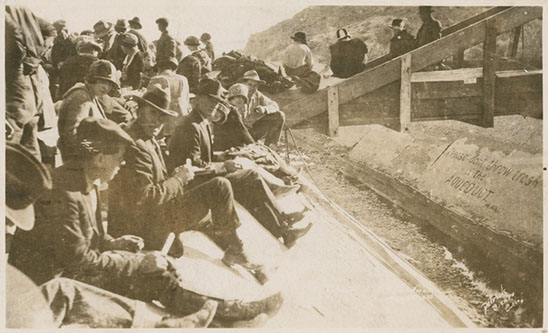 Owens Valley "Army of Occupation" on the Los Angeles aqueduct at the Alabama Gates in Owens Valley - 1924. Owens Valley residents eating at the Alabama Gates of the Los Angeles Aqueduct. This photograph may record either the barbecue held the final day of the occupation (20 November 1924) or else the meals that wives of the occupiers served. The low water in the spllway indicates that the picture was shot towards the end of the occupation. Writing on canal wall: "Please don't throw trash in the AQUEDUCT." |
|
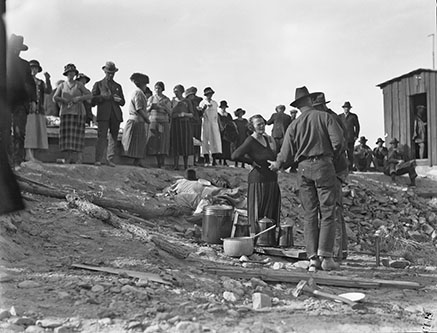 Group gathered near Los Angeles aqueduct, Inyo County, 1924 Possibly related to Los Angeles Times article, November 17, 1924, Water Fight History Told, Controversy Between City and Owens Valley Ranchers Began Twenty Years Ago Two men and one woman in conversation standing near campsite, with pots, buckets and bundles on rocky ground, with group of about 25 men and women gathered on rocky slope in background, some holding dippers or cups, with small building at right " |
|
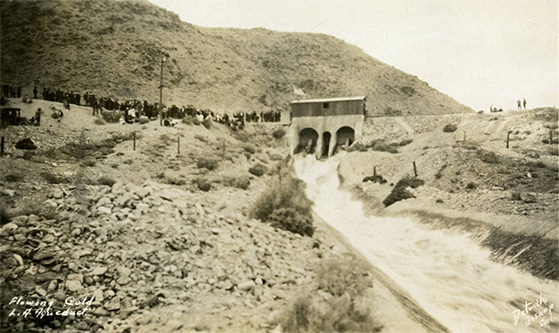 Owens Valley "Army of Occupation" on the Los Angeles aqueduct at the Alabama Gates in Owens Valley - 1924. Bishop, California ranchers releasing water from the Alabama Gates of the Los Angeles Aqueduct. This photograph may have been taken during the initial stages of the occupation since the water is flowing strongly. |
|
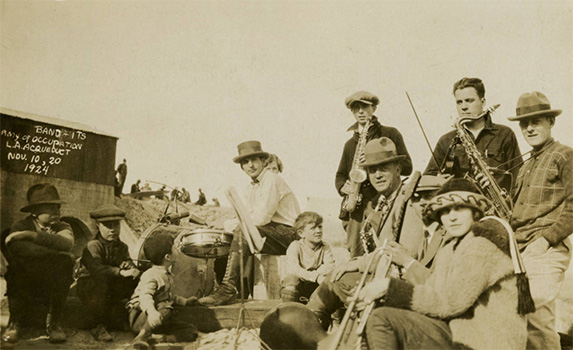 Owens Valley "Army of Occupation" on the Los Angeles aqueduct at the Alabama Gates in Owens Valley - 1924. Band of musicians in front of Alabama Gates of the Los Angeles Aqueduct. Children surround musicians. Western star Tom Mix, shooting a movie in the nearby Alabama Hills, supposedly sent a band to the Gates in support of the occupiers. |
|
Photos Courtesy of Rich McCutchan Archives |
|
The Los Angeles aqueduct was bombed or otherwise vandalized in at least 10 incidents from 1924 to 1931. Cf. (1) Los Angeles Times article, 20 June 1927, “City Aqueduct Again Blasted, Dynamite Tears Out Sixteen-Foot Section, Fourth Recent Outrage Done During Night Hours, Explosion Occurs Two Miles South of Lone Pine.” The article states: “A heavy charge of dynamite exploded in the fourth attempt within the past month … shattered a sixteen-foot panel of waterway at the Puddle Creek Delta, two miles southwest of Lone Pine … Other outrages. Previous acts of violence against the Aqueduct are as follows: On the 5th inst., the side walls of a large open concrete conduit at the mouth of Cottonwood Canyon were wrecked by a charge of dynamite … May 28, 1927: Approximately 300 feet of the Aqueduct system was blown out at Big Pine … May 27, 1927: … a charge of explosive in No Name Canyon destroying about 450 feet of iron pipe … May 14, 1926: A ten-foot hole was torn out of the concrete Aqueduct by dynamite … about one mile south of the spillway in the Alabama Hills. November 24, 1924: A mob of men … opened the Alabama control gates … between Independence and Lone Pine … May 21, 1924: A heavy charge of dynamite was set off against an open portion of the Aqueduct at a point two miles north of Lone Pine. … No actual damage …” Cf. (2) Los Angeles Times article, 17 July 1927, “Blasts Peril Owens Mills, New Aqueduct Dynamitings Bring Contingency, Lake Level May Tie Up Chemical Plants, Large Repair Crews Rush Reconstruction Work.” The article states: “… two dynamite blasts … early yesterday wrecked the Aqueduct … The latest explosions occurred at Thebaut gate, eight miles north of Independence, and at Tuttle Creek south of Lone Pine. …” Cf. (3) Los Angeles Times article, 3 Nov. 1931, “Officers Trail Aqueduct Dynamiting Suspects, One of Pair Sought Here as Blast Rips Grapevine Siphon; No Water Shortage.” The article states: “Two men were being sought last night for complicity in the explosion of a terrific charge of dynamite which … tore out a section of the grapevine siphon on the Los Angeles Aqueduct, about fifty miles north of Mojave. …” |
|
|
|
20-Mule-Team History | |
|
|
Manzanar Internment Camp Portraits, History etc. | |
|
More Owens Valley Aqueduct Portraits & History |
|
|
|
Mt. Whitney Pack Trains 1950s Brochure |
|
|
|
Bessie Brady Steamer |
|
|
|
Packing Equipment |
|
Sign Guestbook View Old Guest Book Entries Oct 1999 - Feb 2015 (MS Word) |
 CONTACT the Pigmy Packer |
View Guestbook View Old Guest Book Entries Oct 1999 - Feb 2015 (PDF) |
